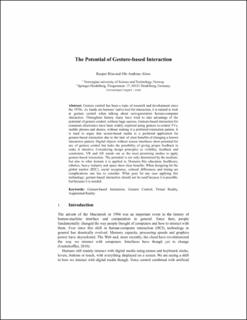The Potential of Gesture-Based Interaction
Chapter
Accepted version

Åpne
Permanent lenke
https://hdl.handle.net/11250/2733261Utgivelsesdato
2020Metadata
Vis full innførselSamlinger
- Institutt for design [1132]
- Publikasjoner fra CRIStin - NTNU [38289]
Originalversjon
10.1007/978-3-030-49062-1_8Sammendrag
Gesture control has been a topic of research and development since the 1970s. As hands are humans’ native tool for interaction, it is natural to look at gesture control when talking about next-generation human-computer interaction. Throughout history many have tried to take advantage of the potential of gesture control, without huge success. Gesture-based interaction for consumer electronics have been widely explored using gesture to control TVs, mobile phones and drones, without making it a preferred interaction pattern. It is hard to argue that screen-based media is a preferred application for gesture-based interaction due to the lack of clear benefits of changing a known interaction pattern. Digital objects without screen interfaces show potential for use of gesture control but lacks the possibility of giving proper feedback to make it intuitive. Considering design principles as visibility, feedback and constraints, VR and AR stands out as the most promising medias to apply gesture-based interaction. The potential is not only determined by the medium, but also in what domain it is applied to. Domains like education, healthcare, robotics, heavy industry and space show clear benefits. When designing for the global market (B2C), social acceptance, cultural differences and timing are complications one has to consider. What goes for any case applying this technology; gesture-based interaction should not be used because it is possible, but because it is needed.